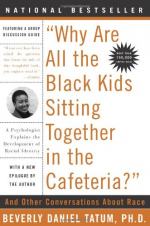
|
| Name: _________________________ | Period: ___________________ |
This test consists of 5 multiple choice questions, 5 short answer questions, and 10 short essay questions.
Multiple Choice Questions
1. Who does the author claim are most guilty of a culture of silence in Part V, Breaking the Silence, Chapter 10, Embracing a Cross-Racial Dialogue?
(a) Asians.
(b) Whites.
(c) Native Americans.
(d) Blacks.
2. Puerto Rico is Spanish for what phrase?
(a) Sandy beaches.
(b) Bountiful fruit.
(c) No worries.
(d) Rich port.
3. Barack Obama's mother is from __________.
(a) Kansas.
(b) Mexico.
(c) Ontario.
(d) Georgia.
4. What refers to the cultural values and behavioral patterns distinctive of a particular group in a society?
(a) Autonomy.
(b) Ambiguity.
(c) Subculture.
(d) Analogy.
5. In what year did Virginia law state that to be defined as "mulatto," a person had to have at least one-quarter African ancestry?
(a) 1946.
(b) 1822.
(c) 1872.
(d) 1907.
Short Answer Questions
1. What is the first of three stages of racial consciousness in minority groups delineated in Jean Phinney's model of ethnic identity development?
2. What was a landmark decision of the US Supreme Court that declared state laws establishing separate public schools for black and white students unconstitutional?
3. In what year did the Mexican-American War begin?
4. Thomas Jefferson had four surviving children by what mixed-race slave?
5. What is a historical colloquial term in the United States for the social classification as black of individuals with any African ancestry?
Short Essay Questions
1. How does the author suggest that Whites deal with their struggle with Whiteness positively in Part III, Understanding Whiteness in a White Context, Chapter 6, The Development of White Identity?
2. When and how does Tatum describe the need for racial consciousness in biracial children in Part IV, Beyond Black and White, Chapter 9, Identity Development in Multiracial Families?
3. How is biracial development approached by the author in Part IV, Beyond Black and White, Chapter 9, Identity Development in Multiracial Families?
4. What does Tatum claim affirmative action is and is not in Part III, Understanding Whiteness in a White Context, Chapter 7, White Identity and Affirmative Action?
5. What are the costs of a lack of a racial dialogue, according to the author in Part V, Breaking the Silence, Chapter 10, Embracing a Cross-Racial Dialogue?
6. What ethnic group is most responsible for a culture of silence according to the author in Part V, Breaking the Silence, Chapter 10, Embracing a Cross-Racial Dialogue? Why?
7. What do productive racial dialogues promote, according to the author in Part V, Breaking the Silence, Chapter 10, Embracing a Cross-Racial Dialogue?
8. What problems does Tatum discuss which can result from the different concepts of affirmative action in Part III, Understanding Whiteness in a White Context, Chapter 7, White Identity and Affirmative Action?
9. How does Tatum describe the development of white identity in Part III, Understanding Whiteness in a White Context, Chapter 6, The Development of White Identity?
10. What is Tatum's response when white individuals in her seminars present reverse discrimination in regards to affirmative action in Part III, Understanding Whiteness in a White Context, Chapter 7, White Identity and Affirmative Action?
|
This section contains 950 words (approx. 4 pages at 300 words per page) |

|




